Making/Using Molds, Tutorials
How To Make Holiday Ornaments with Epoxy Clay, Molding Putty & Colorized Resin!
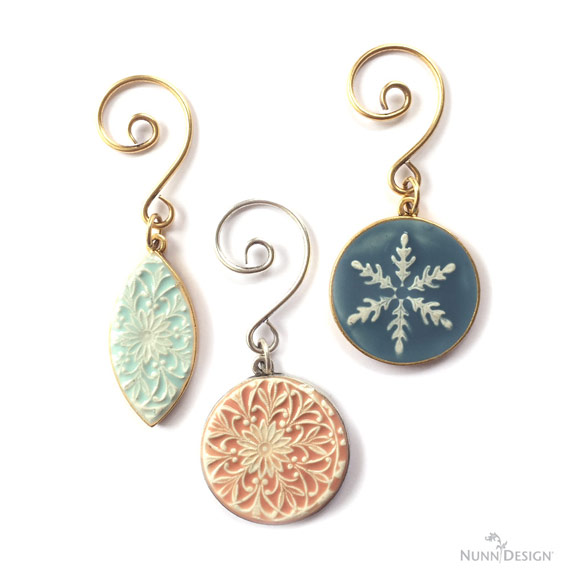
This is our annual tutorial repost from a holiday ornament workshop we taught online in a previous year. I can’t wait to unpack my holiday ornaments because all of these samples are now within those boxes and I’m looking forward to seeing them.
Here is what you will learn in this tutorial:
- How to create molds using Easy Mold Silicone Putty
- How to mix and sculpt Epoxy Clay
- How to mix and colorize Nunn Design Resin with Castin’ Craft Opaque Pigments
- How to apply the colorized resin to the Crystal Clay Ornaments.
Choose Your Resin Color:
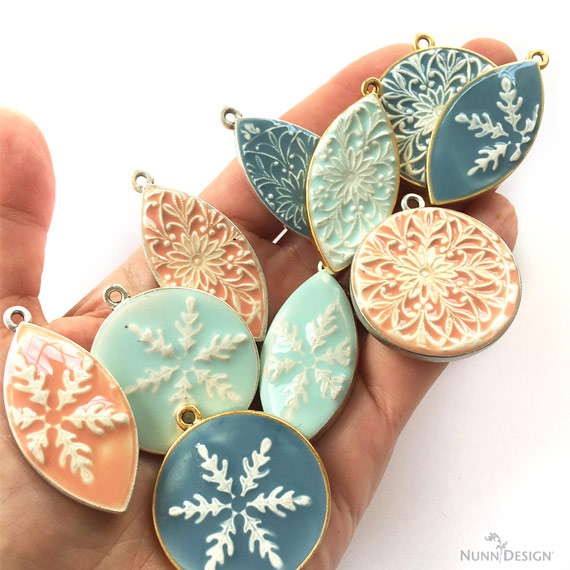
What colors will you make? Check out our Pantone Color Resin Formula Cheatsheet with new 2022 color formulas!
Learn How:
Supplies Needed:
- Nunn Design 2-Part Resin Kit
- Nunn Design Grande Pendant Navette
- Nunn Design Grande Pendant Circle
- Ornament Hooks
- Jumprings
- Epoxy Clay
- Easy Mold Silicone Putty
- Brass Metal Stamping or Vintage Button
- Castin’ Craft Opaque Pigments
Other Supplies Needed:
- Wet wipes
- Toothpicks or headpins
- Gloves
- Timer
- Plastic Bag
- Business cards or card stock
- Q-tips
- Rubbing Alcohol
Tools Needed:
- Needle Nose Pliers
As we close out technique products from our product line, we have been asked for suggestions on other products that we would recommend. Please take a look at this blog post for alternative suggestions for Nunn Design 2-Part Resin, Crystal Clay and other items: Replacement Technique Products
Watch Tutorial Video from previous Facebook Live:
In a previous year we did a Facebook Live tutorial walking you through the whole process. Watch this video tutorial while you make your holiday ornaments!
Prepare Your Nunn Design Bezels
Step 1. The Nunn Design Findings are oxidized to provide the aged look to the precious metal plating. The oxidization, when it comes into contact with the Epoxy Clay could change the color of the clay.
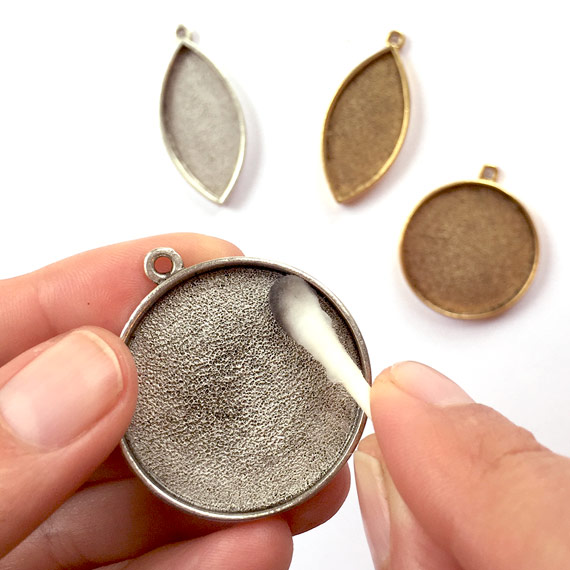
To avoid this, clean the findings thoroughly prior to applying the clay. Get the tip of a Q-Tip wet with rubbing alcohol and clean away any of the blackened oxidization on both sizes of the bezels.
Making the Silicone Mold
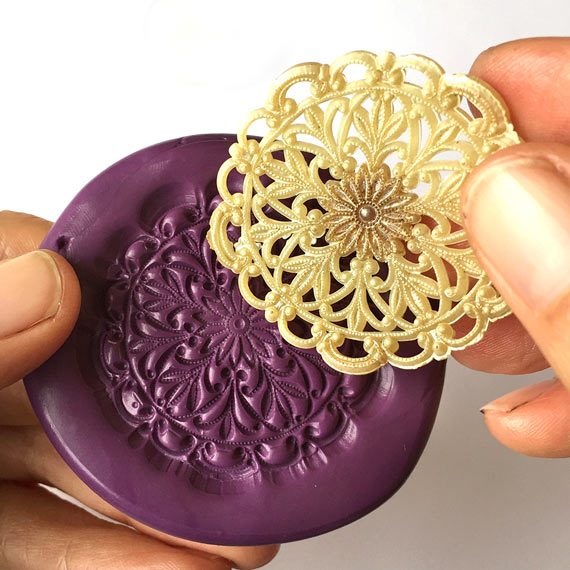
Step 2. Select a Nunn Design Brass Stamping or a vintage button. Brass Stampings or found objects with a lot of relief make the best molds. For this tutorial, I used both a vintage button and a plated brass stamping of a snowflake. Both of these molds are available to purchase or you can create your own molds by following steps 2-6.
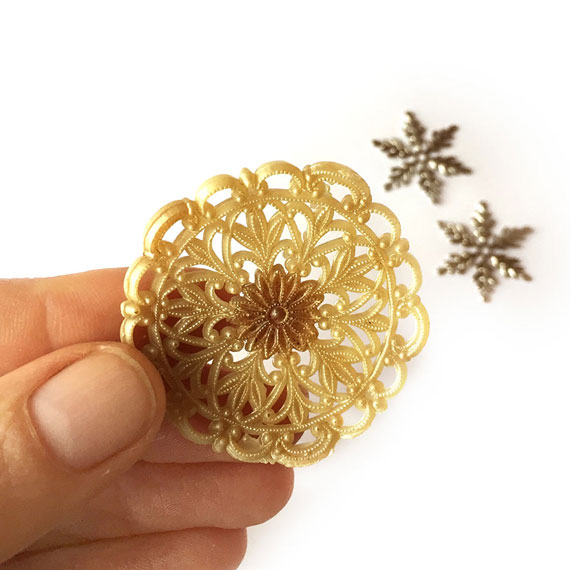
Step 3. Pinch off two equal-sized balls of Part A and B of the Easy Mold Silicone Putty. Getting the knack for mixing just the right amount of putty will take some practice. You might mix too much or too little putty the first time. Try your best to guess how much putty you will need to have approximately 1/8” putty around the outside edge of your bezel’s rim. You will also want the thickness of the silicone putty to be approximately 1/8.”
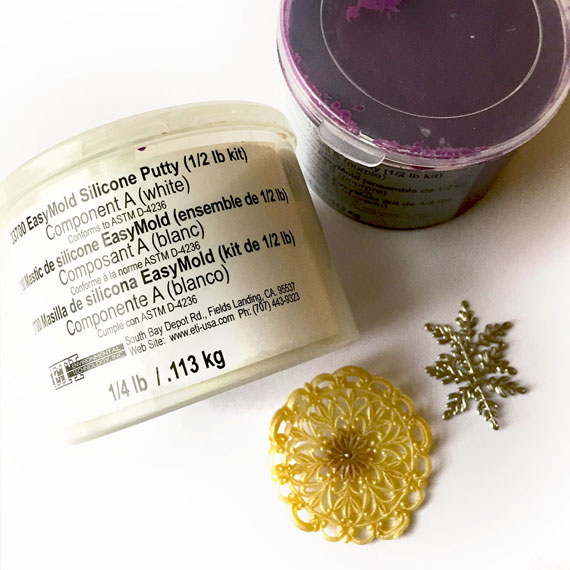
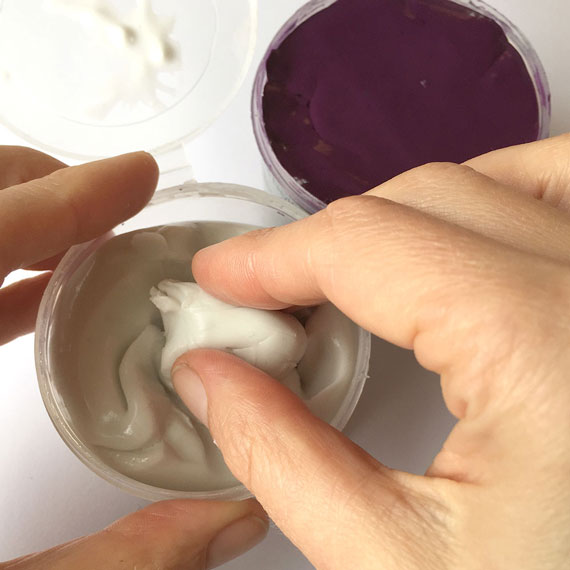
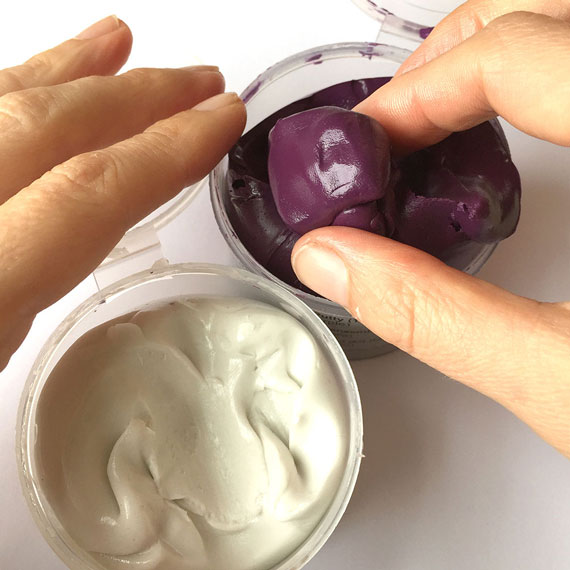
Step 4. The Easy Mold Silicone Putty has a 3-minute working time before it begins to harden and not take the impression. Knead both part A and part B together until the putty is blended completely and has a uniform color.
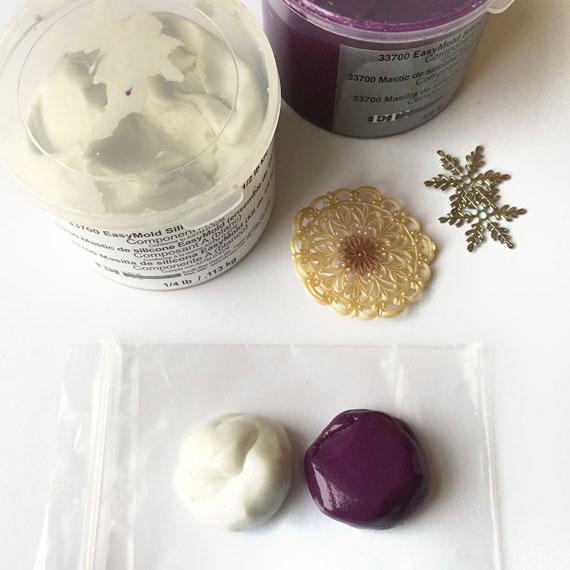
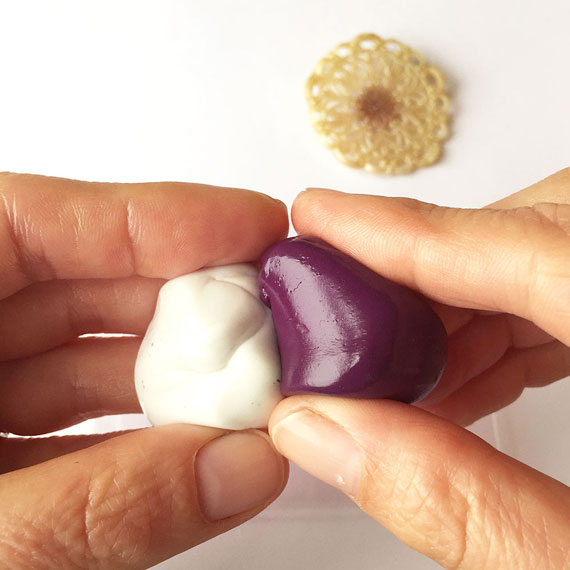
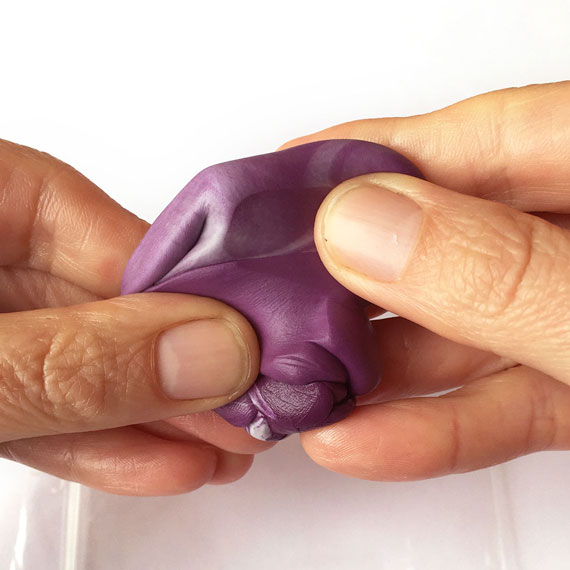
Step 5. Roll the fully mixed Easy Mold Silicone Putty into a round ball and flatten slightly. Make sure the putty is smooth and not wrinkled (the creases in the putty will show up in the mold).
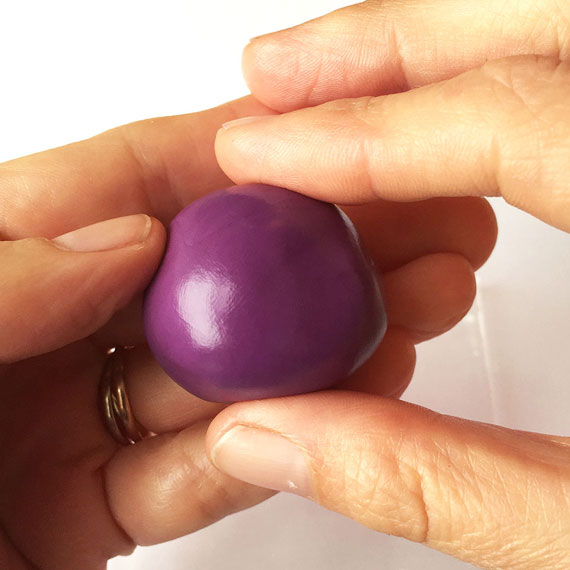
I like to use the lid of the Easy Mold Silicone Putty to create a nice flat smooth disk. Place the mixed silicone ball onto a small plastic bag and press the lid evenly down into the putty.
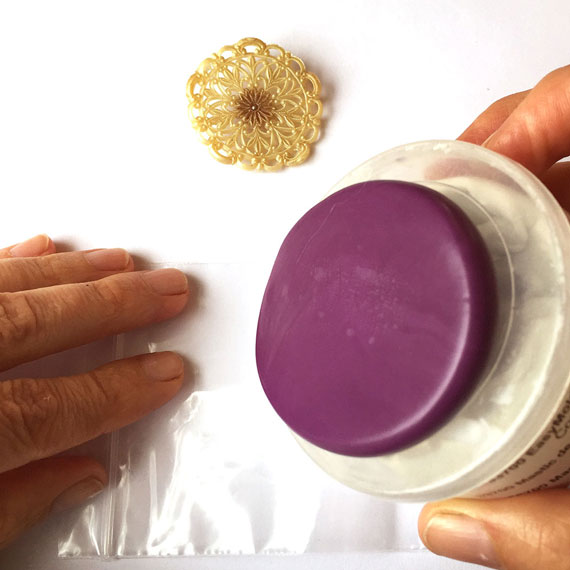
Remove the putty from the lid of the container and press the button or brass stamping into the silicone putty, but not so far into the putty that you hit the bottom. Leave the button or brass stamping in the putty for 5 minutes or until the putty is hard to the touch.
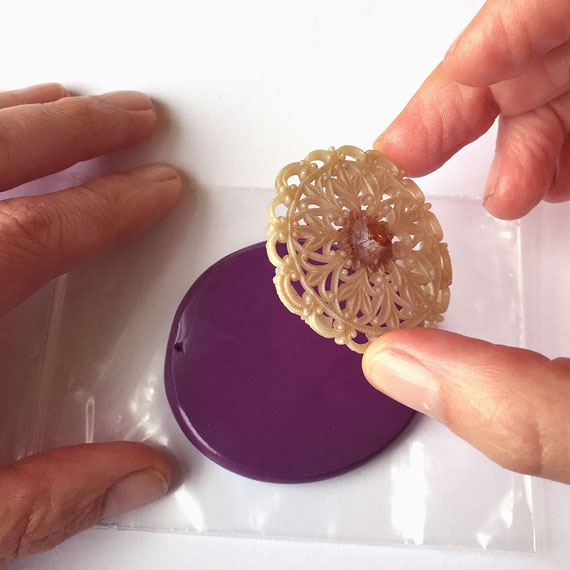
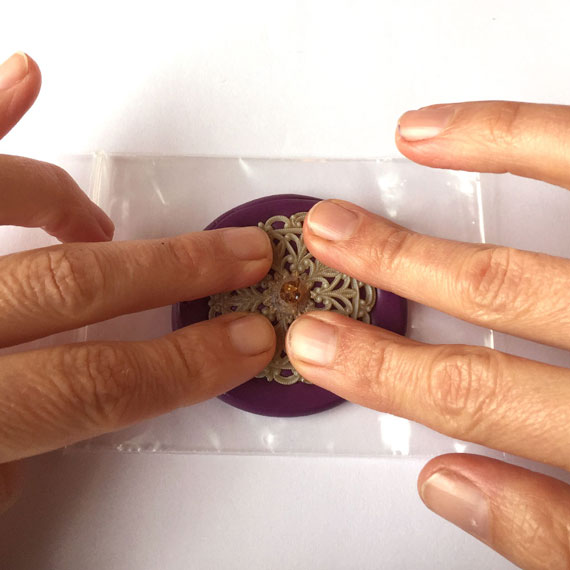
Step 6. Once the molding putty is hard to the touch, bend the sides and remove the button.


Step 7. Here is what it looks like to create a mold using the brass stamping.
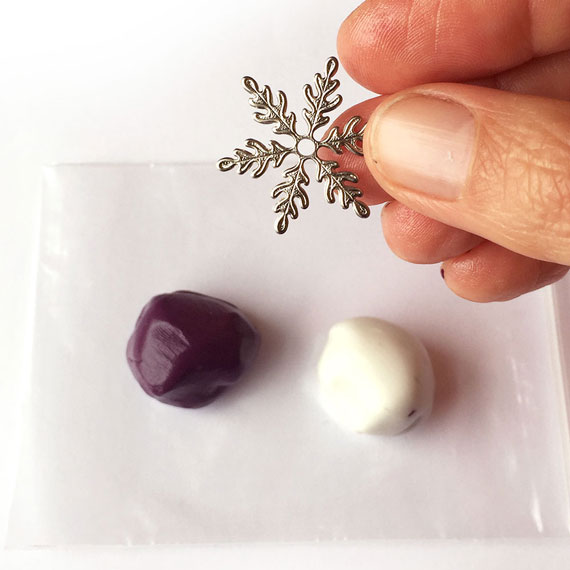
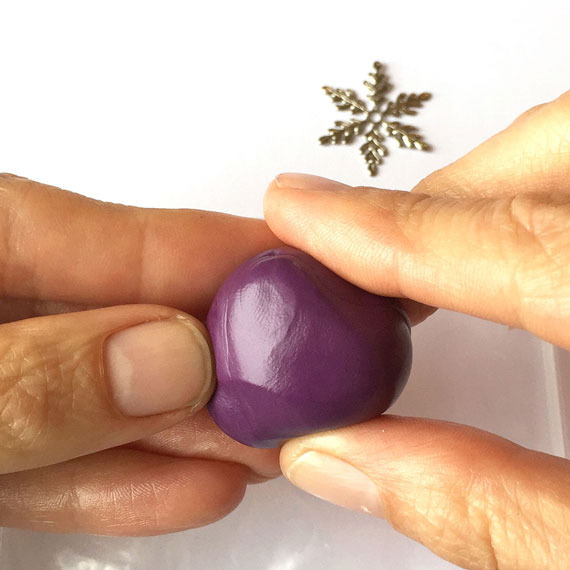
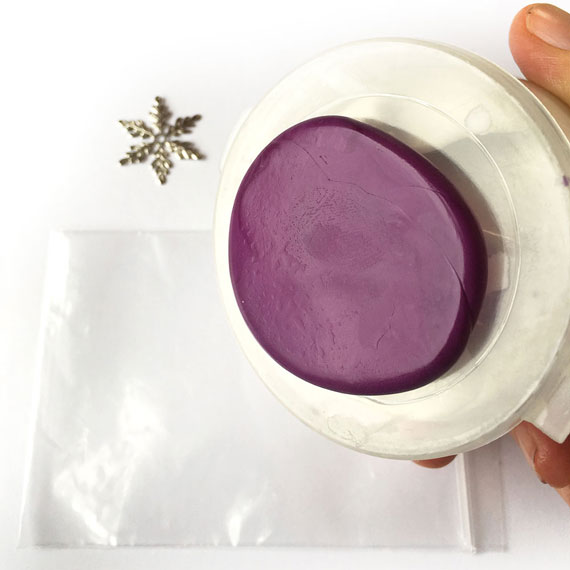
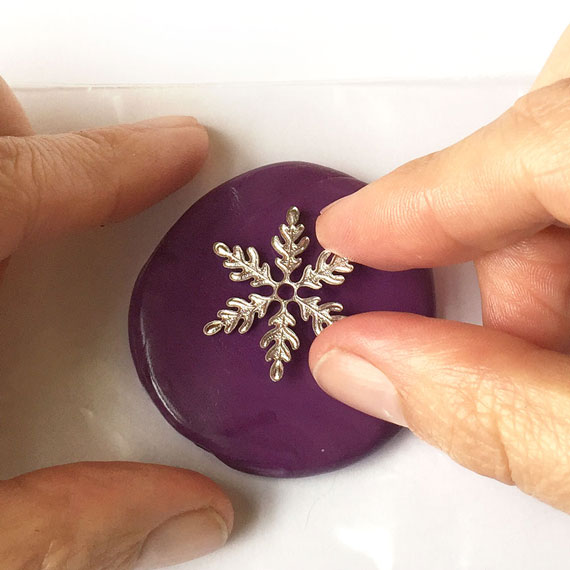
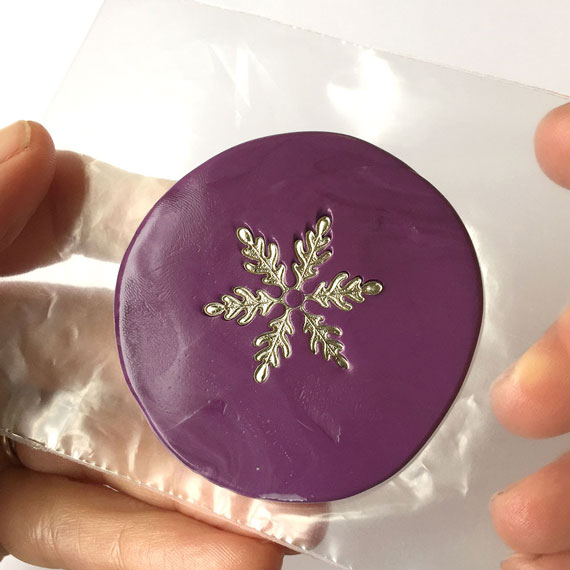
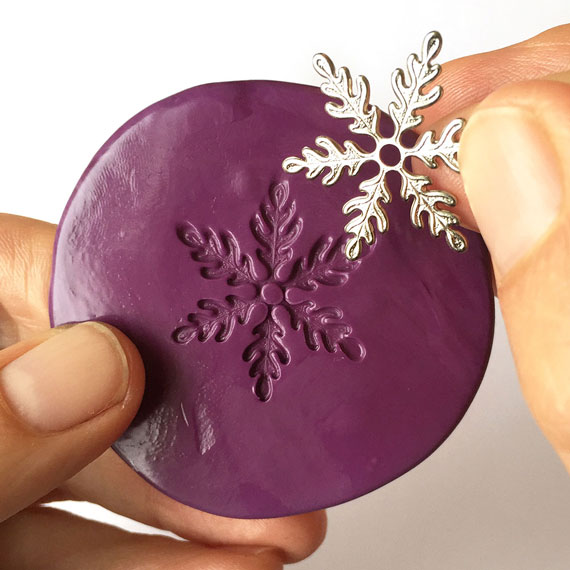
Mix Epoxy Clay:
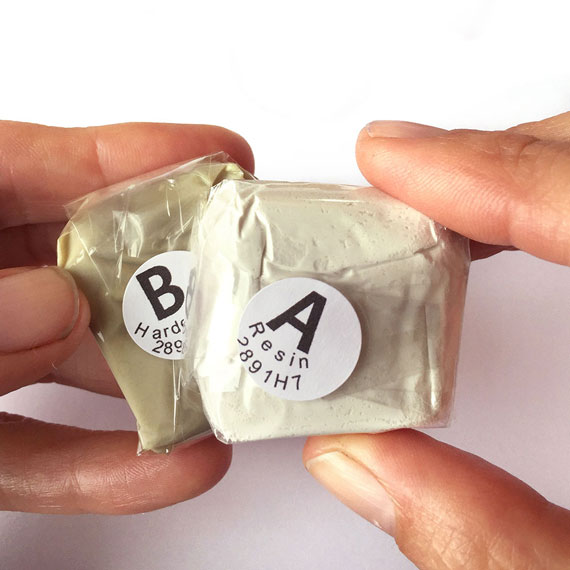
Step 8. Follow the manufacturer’s instructions for the handling and mixing of the Epoxy Clay. While wearing gloves, pinch off two equal-sized balls of Part A and Part B and blend together fully until the clay is no longer marbled and uniform in color.
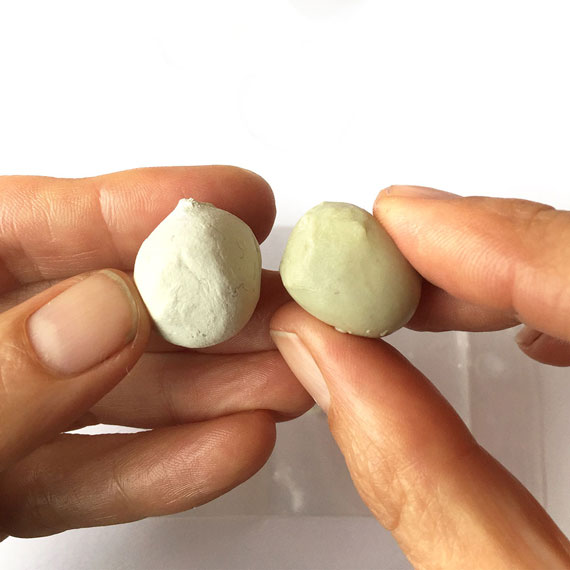
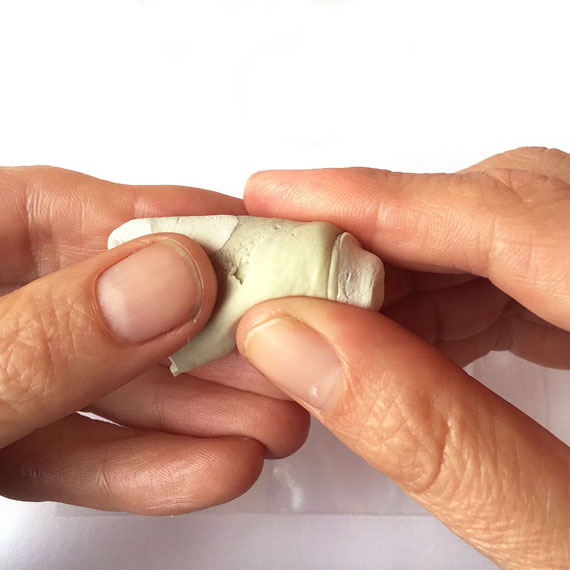
You have approximately 90-120 minutes of working time before the clay starts to harden, so take your time. Once the clay is thoroughly mixed, remove your gloves to make it easier to work with the clay. For this tutorial, I mixed a Whopper Malted Milk Ball size of both Part A and B of clay because I wanted to create multiple ornaments.
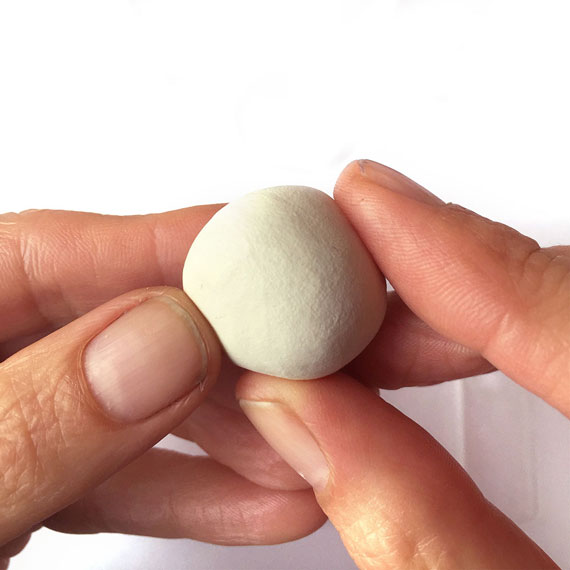
Apply Epoxy Clay into the Nunn Design Bezel:
Step 9. For each ornament I pinched off a large blueberry ball of clay.
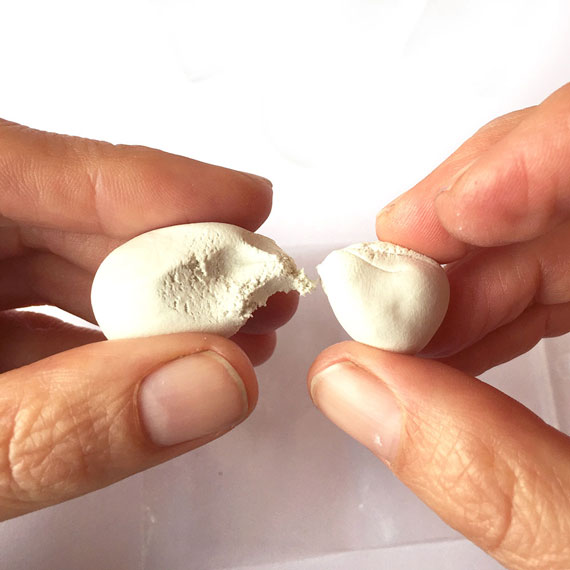
Roll the thoroughly mixed Epoxy Clay between your palms until it forms a smooth round ball. I like it to be smooth because it prevents from having creases once the impression is made.
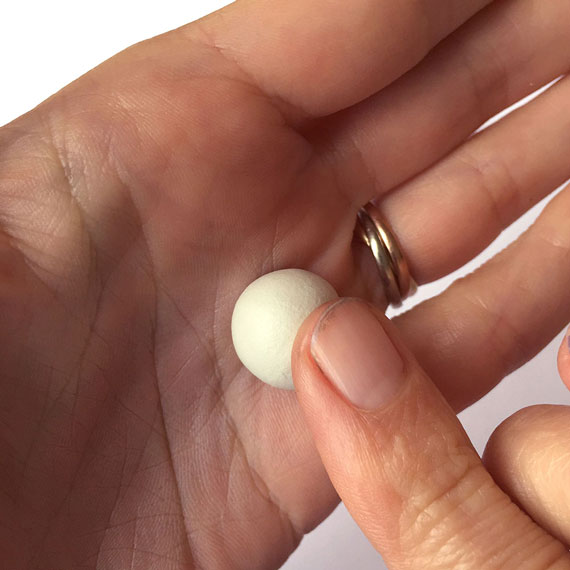
Press the ball into your bezel with your fingers to create an even smooth surface in the clay.
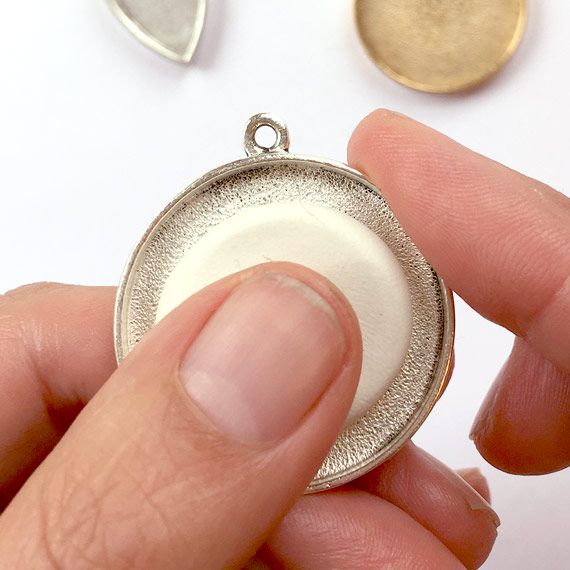
TIP: It is easy to get little fibers mixed into the clay. Use a toothpick to remove them from the clay and pat the surface smooth again
Step 10. If you put too much clay inside the bezel it will squish out the sides and you will have excess clay to clean up. If you don’t put in enough, you might not get a good impression in the clay from the mold. Regardless, both are easy things to fix, so it might take a little experimenting to get it just right. If the Epoxy Clay is not flush with the edge of the bezel you can add more or pinch off excess.
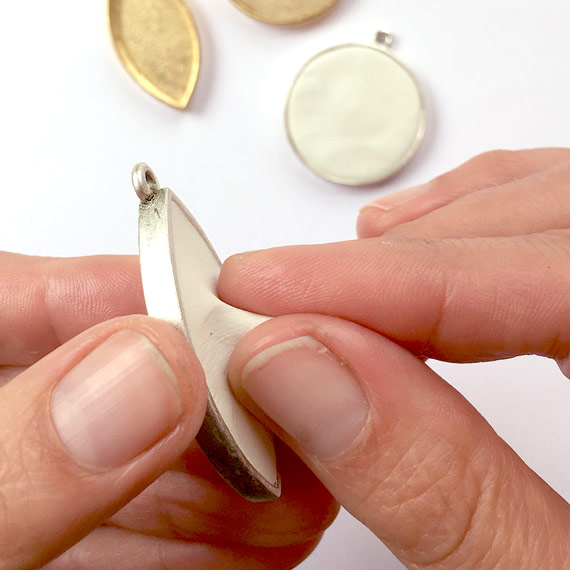
Tip: If filling the corners with Epoxy Clay is challenging on the square and rectangle-shaped bezels, use a toothpick to press the clay up into the corners of the bezel. Pat down the toothpick marked clay with your fingers until smooth.
Creating the Impression:
Step 11. Place the Epoxy Clay filled bezel face down onto the putty mold and press down evenly. To make sure I have a really good impression, I like to pick up the mold and press the mold into the clay, as well as pressing the bezel down into the mold.
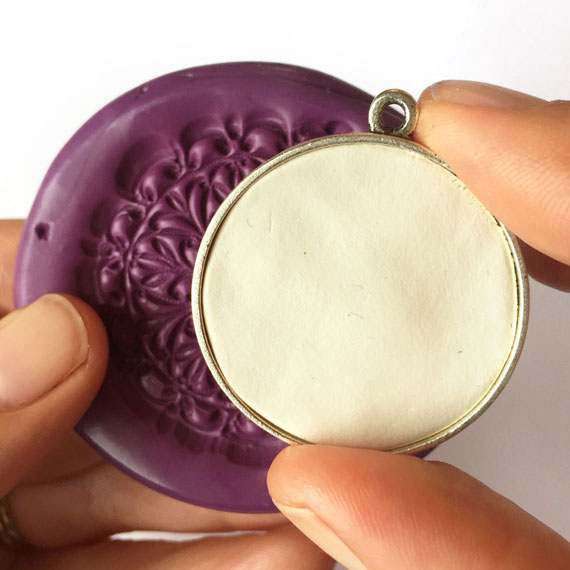
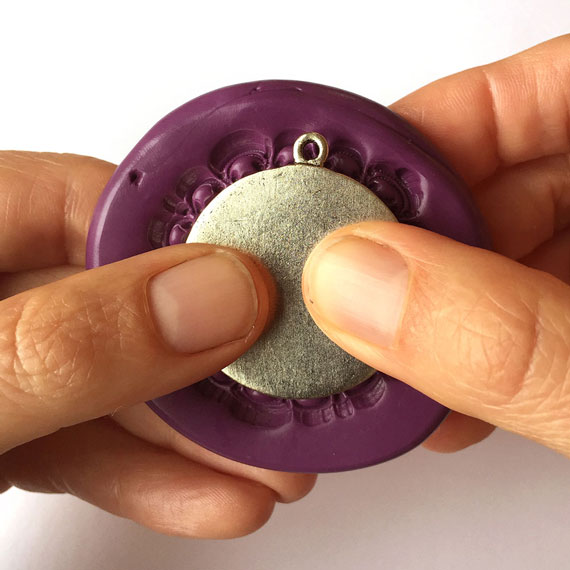
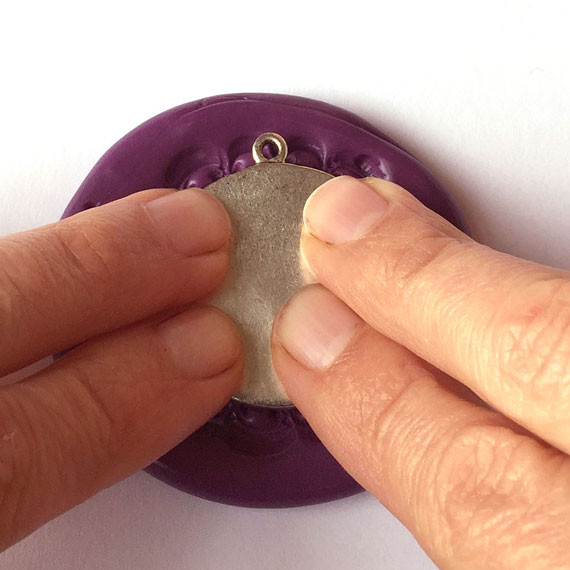
If you don’t like the impression that you make, pat the impression in the Epoxy Clay with your fingertips until you have a smooth surface once again and press down into the mold again.
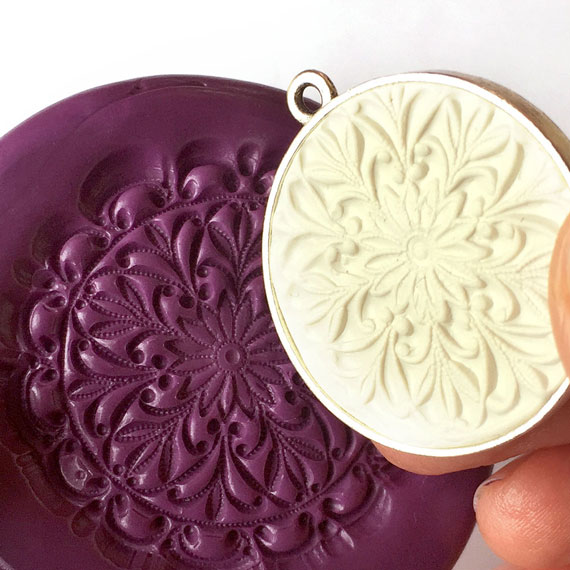
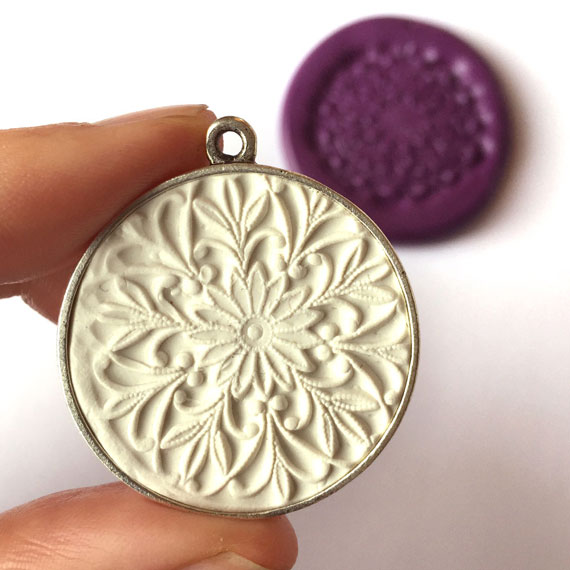
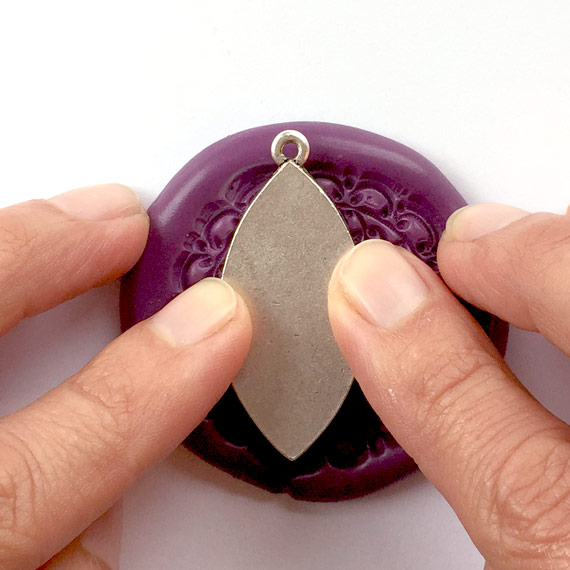
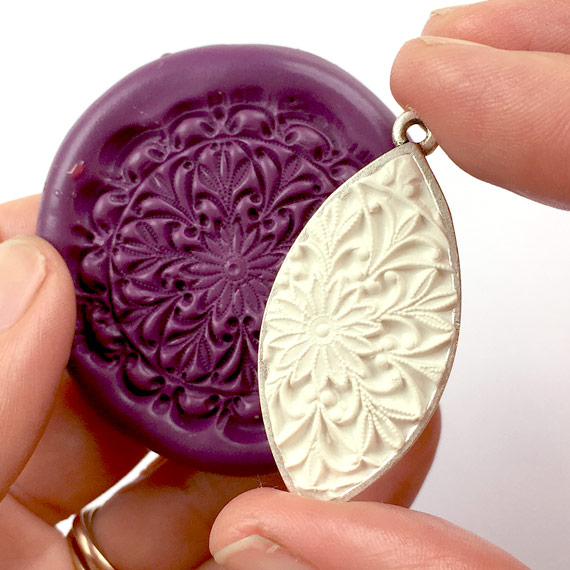
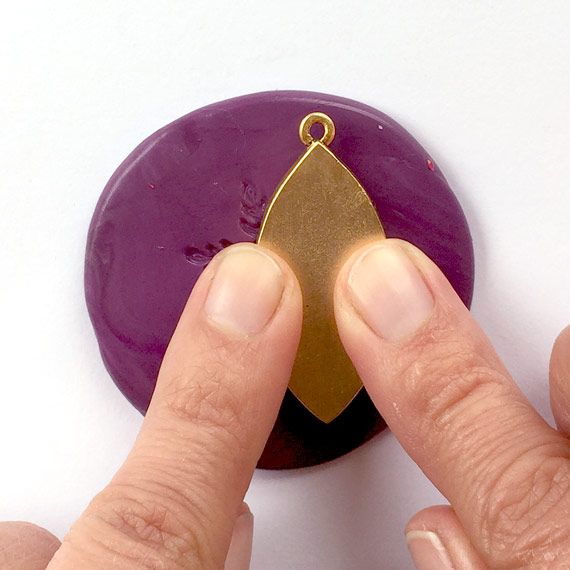
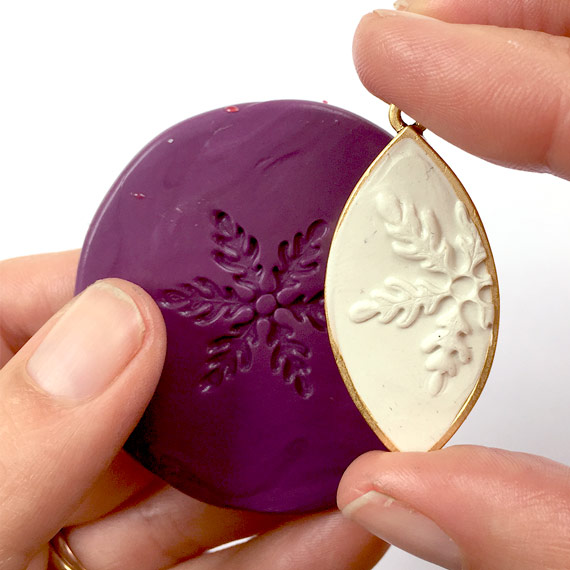
Step 12. Using a wet-wipe, clean up any excess Epoxy Clay that might have been left on the bezel. The Epoxy Clay hardens like cement, so cleaning it up now and being tidy as you go makes the process easier and the results so much nicer.

If you have indentations in the Epoxy Clay, use a Q-Tip to smooth those out.
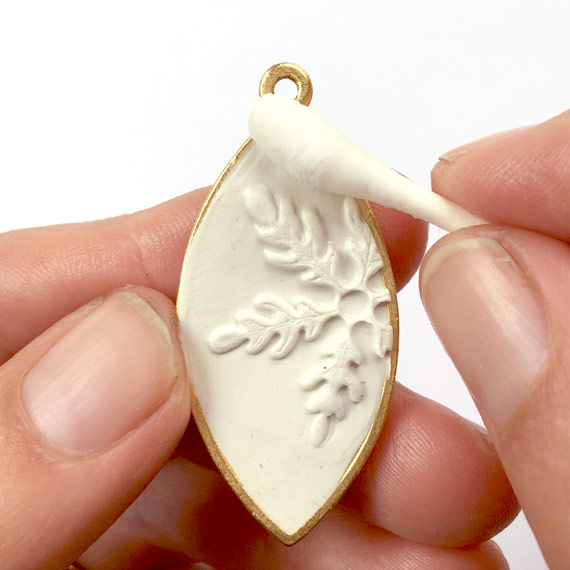
TIP: I suggest letting the Epoxy Clay cure for 2 hours or until firm to the touch before placing on the colorized resin.
Here is a visual showing the approximate amount of bezels you can fill with 25g or 50g packages of Epoxy Clay, putting about 3.3g of Epoxy Clay in each bezel. The Grande Pendant Circle Single Loop (gpcs) has an inner diameter of 31.6mm and an inner depth of 2mm. The Grande Pendant Navette Single Loop has an inner dimension of 37 x 18 x 2mm. You can weigh your Epoxy Clay with a scale like this.
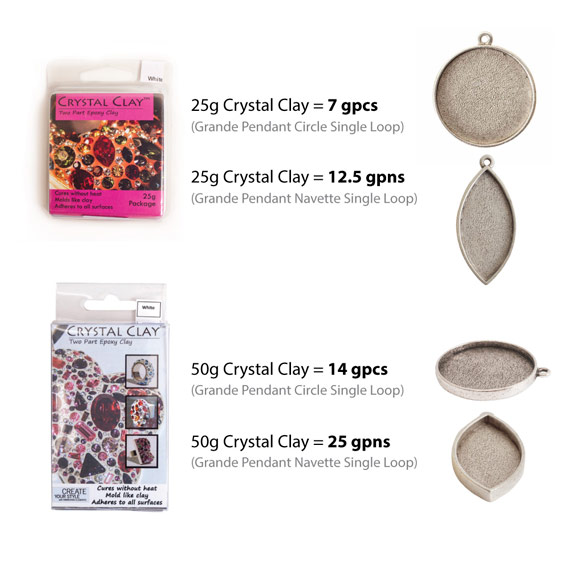
How to Mix Nunn Design 2-Part Resin
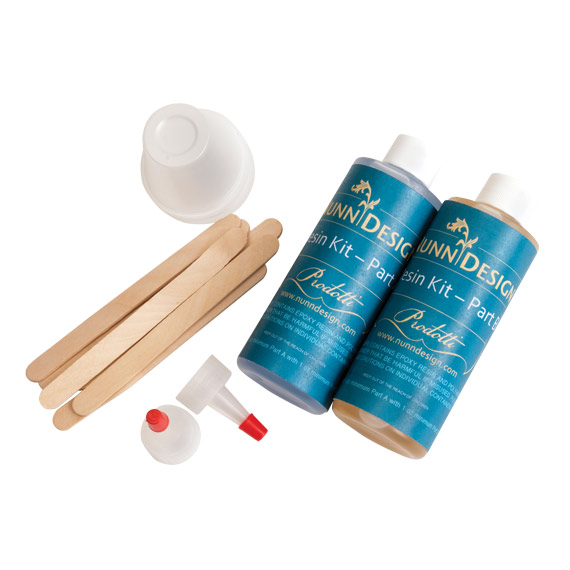
Step 12.
Read the resin instructions for safety concerns regarding the Nunn Design Resin. Put on your latex gloves and I would recommend safety glasses. I wear readers so I think that my eyes are protected. Make sure you have a pile of wet-wipes on the ready!
Step 13. To mix the resin you’ll want to have an exact one-to-one ratio. The one-to-one ratio has to be one tablespoon of Part A first and one tablespoon of Part B. This is a volume thing, not a weight thing. You have to mix the full mixing cup of resin to have the resin properly activate. I thought this was an excuse to get me to use more resin, but trust me, it isn’t! It is important to pour Part A first into the cup and then Part B. It is a chemical thing about part A being heavier or something.
Place one of the mixing cups included in the Nunn Design Resin Kit onto your table. I suggest getting your eyes level with the resin so you can see the lines on the measuring cup. Remove the lid to Part A of your resin kit and slowly pour the resin into the mixing cup up to the 1 Tablespoon mark. I suggest that you go slow until you start to gain more confidence. When you start to get near the 1 Tablespoon line, tilt the Part A bottle down, slowing the flow of the resin. Slowly drizzle the resin into the cup until you have hit the 1 Tablespoon mark EXACTLY! To end the flow of the resin, twist the bottle. Use a wet-wipe to fully clean up resin from the edge of the bottle. Make sure to put the Part A lid back onto the resin bottle.
I fold my wet-wipe over to make sure I don’t contaminate Part B when I clean up the edge of that resin after I pour it. I am also making sure that I don’t get any of the resin onto my hands.Following all the same steps used for Part A, pour Part B into the mixing cup until it is EXACTLY at the 2 Tablespoon mark. Clean up the edge of the resin bottle and securely twist the Part B cap back onto the resin.
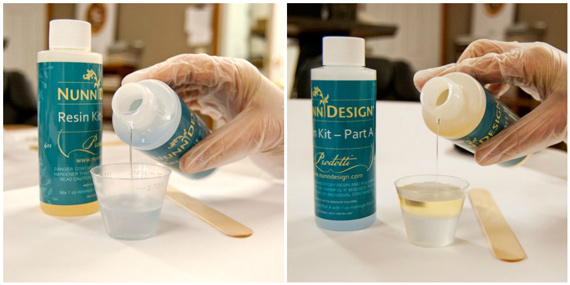
Step 14. Set your timer for 2 minutes. Using the stir stick from your Nunn Design Resin Kit, slowly and carefully stir your resin scraping the bottom of the cup and the sidewalls as you stir. Go slowly because it is easy for the cup to overflow. I hold the cup down at the base and use my fingers to help rotate the cup around. Stop from time to time and scrape the resin from the sides of the stir stick and continue to stir for the full 2 minutes. If your resin is still cloudy after your timer has gone off, continue to mix until clear.
After mixing is complete and your resin is clear, scrape both sides of your stir stick on the edge of your resin filled cup.
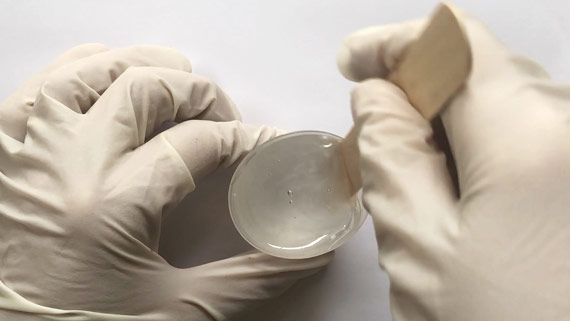
Another habit that I have developed is being aware of where I rest my stir sticks. To avoid getting resin all over my work surface, I like to rest the resin stir sticks in one of the mixing cups or onto a small Ziploc. I can easily peel the resin off of the Ziploc and reuse it. I can also reuse my stir stick once the resin has fully cured. I do know people who wipe out and reuse their mixing cups, but I haven’t done that so I cannot recommend it.
Colorizing the Nunn Design Resin
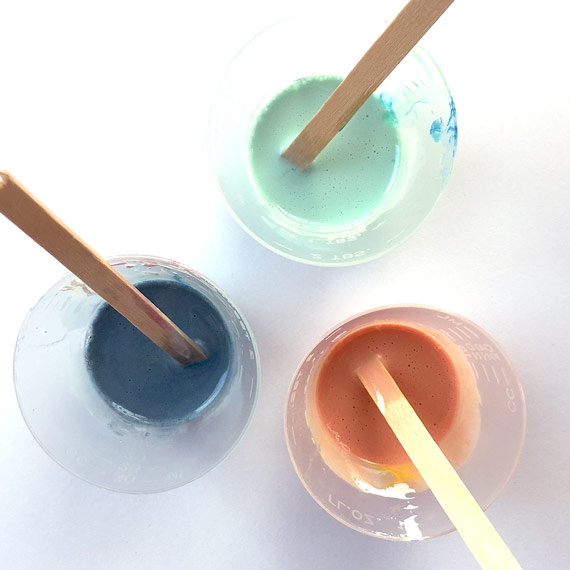
Step 15. To create Pantone Colors, take a look at this chart, Pantone Color Cheat Sheet, to learn how to mix pigments to achieve a variety of colors. We’ve just updated the Cheat Sheet to include our new 2020 Pantone colors, as well as the previous years!
For this tutorial, I colorized my resin with the formulas below using Castin’ Crafts Opaque Pigments:
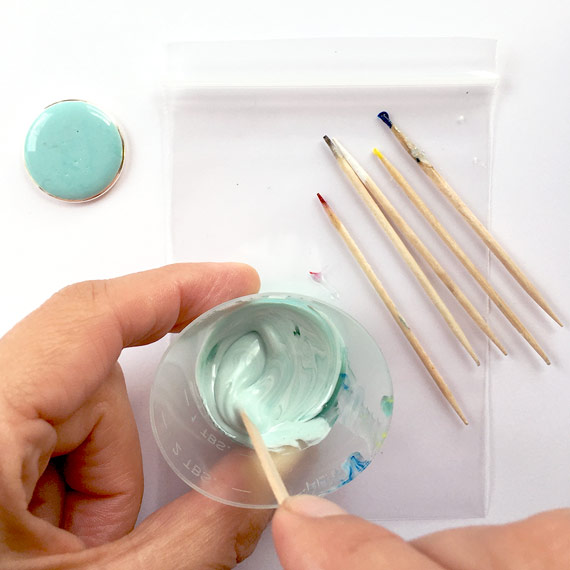
Pantone Color-14-4620 TPG, Island Paradise
Formula:
- 1 tsp Nunn Design Resin
- 1 tiny toothpick tip Blue
- 1 tiny toothpick tip Yellow
- 4 toothpick tips White
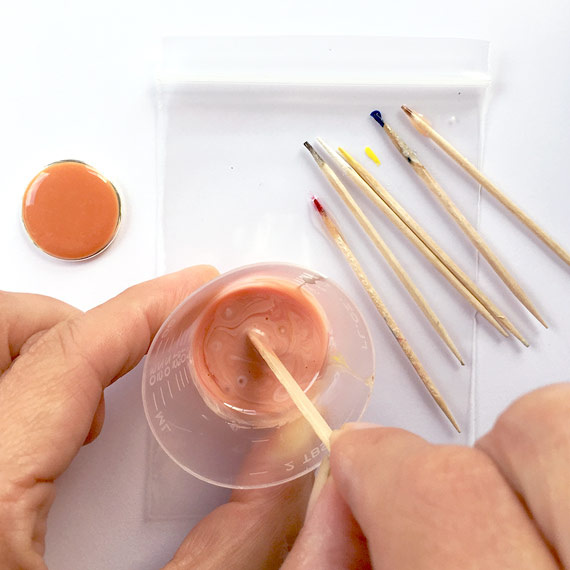
Pantone 15-1247 TPX, Tangerine
Formula:
- 1 tsp Nunn Design Resin
- 1 tiny toothpick tip Red
- 1 toothpick tip White
- 2 toothpick tips Yellow
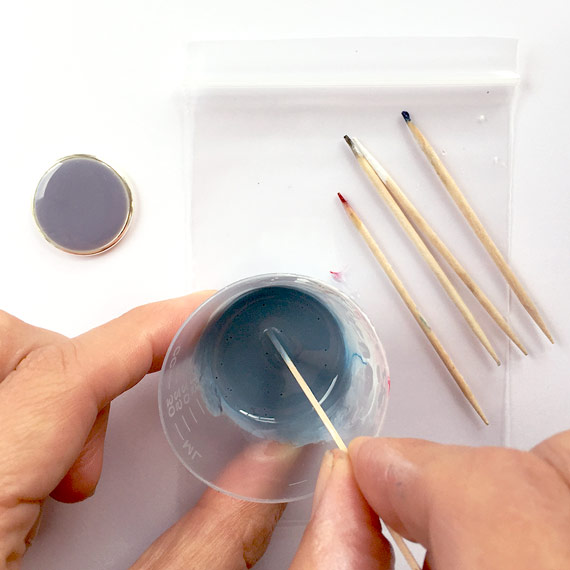
Pantone 16-3905 TCX, Lilac Gray:
Formula:
- 1 tsp Nunn Design Resin
- 2 toothpick tips Black
- 1 tiny toothpick tip Black
- 3 toothpick tips White
- 1 tiny toothpick tip Blue
- 1 tiny toothpick tip Red
Step 16. To colorize the resin, place another empty resin mixing cup onto your work area.
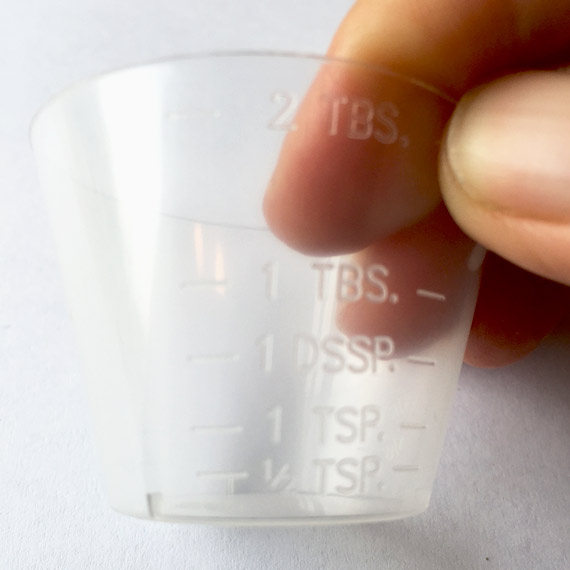
Pour the clear, mixed resin into the cup, filling it to the 1 TSP mark.
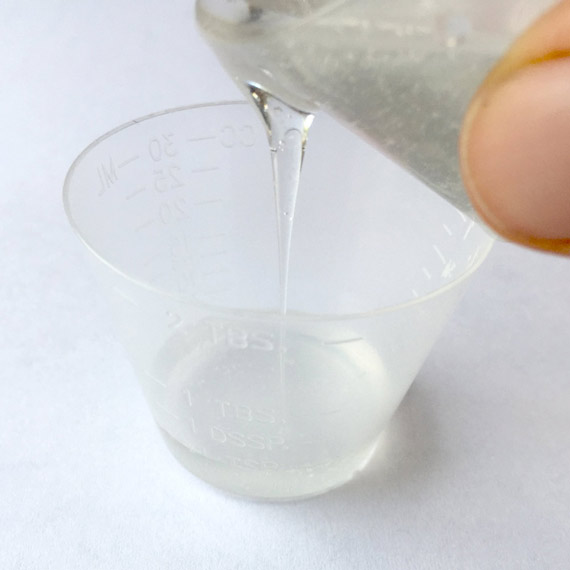
The Castin’ Craft Opaque Pigments are very potent. Let’s define what a “tiny toothpick tip” and a “toothpick tip” amount of colorant should look like. This is not an exact science. If you don’t get the exact amount, your color will still come out fairly close.
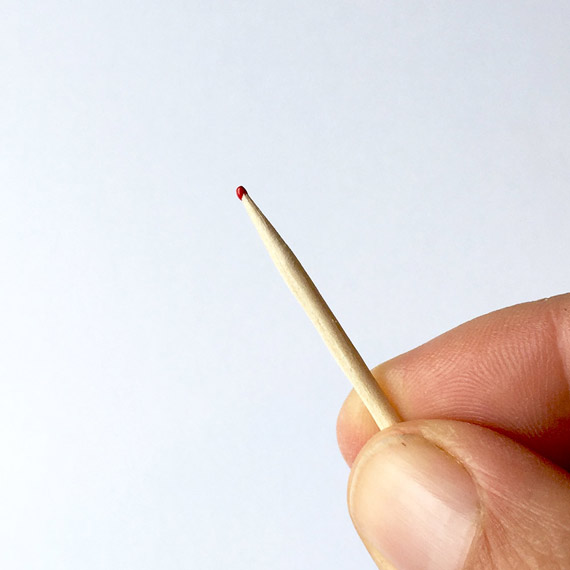
A “tiny toothpick tip” should look like this.
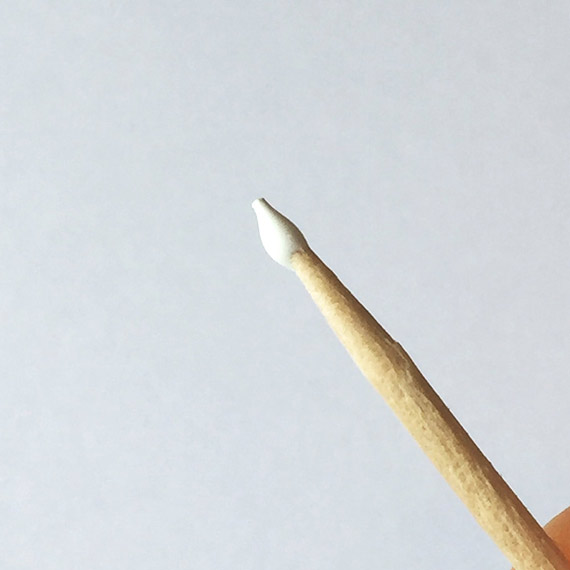
A “toothpick tip” should look like this.
Add in the colorants according to the color formulas and then stir gently until the colorants are fully mixed together. Let resin sit for 5 minutes to let the bubbles rise to the surface and pop.
Tip: Be sure that the colorant does not equal more than 10% of your resin as having more than 10% could cause issues with curing.
Applying the Colorized Resin
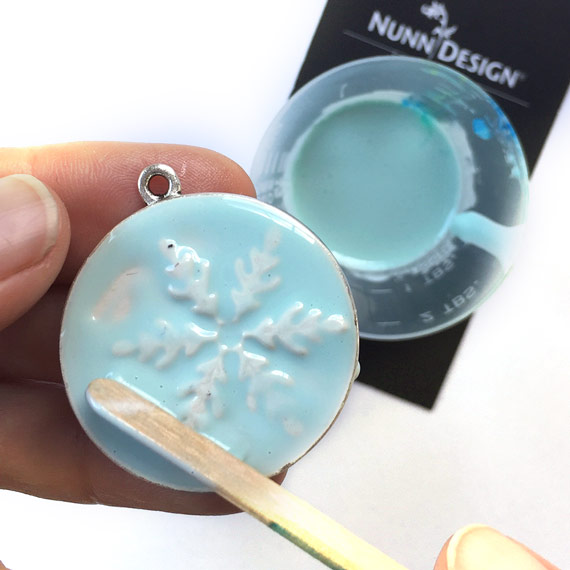
Step 17. I tend to work in a small area (typically my kitchen table), so I like to work on a surface that projects can be easily moved around and not disturbed. Place some business cards or some heavy card stock onto your work surface, making it easy to move the pendants without getting any resin on your fingers.
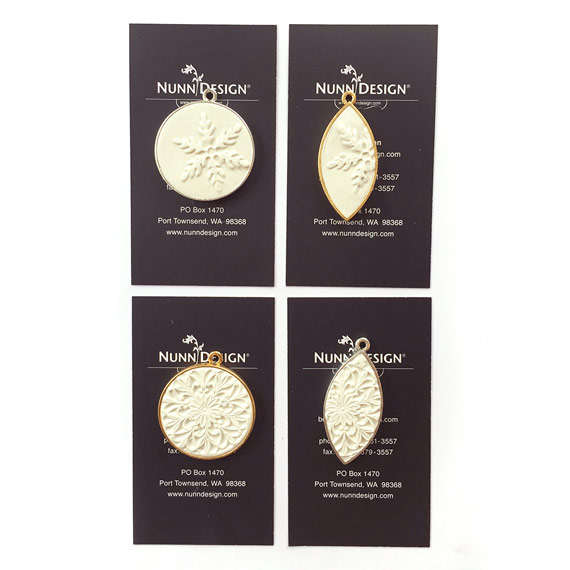
TIP: I would recommend covering the card with glossy packing tape. This will prevent the resin from sticking to the paper.
Step 18. Drizzle a small amount of colorized resin onto the surface of your cured and firm to the touch Epoxy Clay impression.
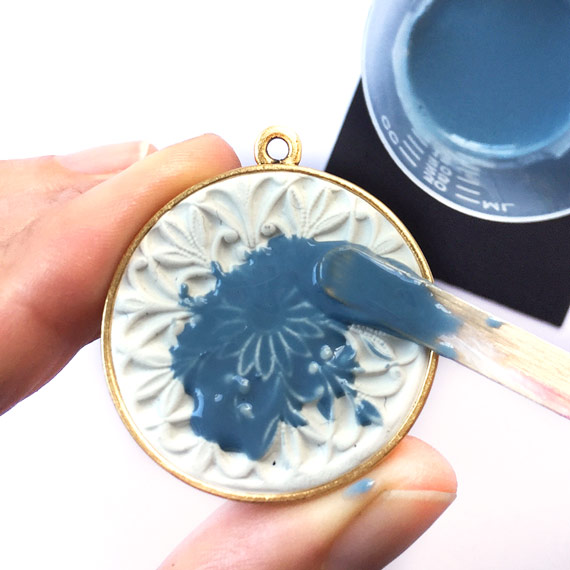
Using a stir stick or toothpick drag the resin over to the side edges. You can also use the stir stick to remove excess resin.
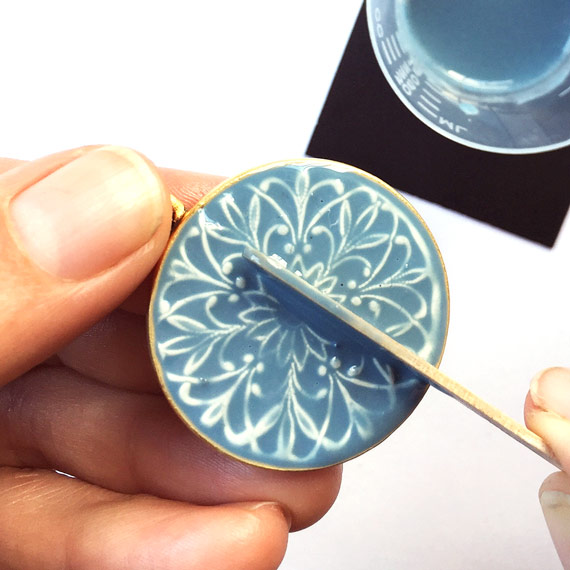
Step 19. Use a wet-wipe to remove the colorized resin for the high points of the impression. Clean off any resin that might be on the sides of the bezel.
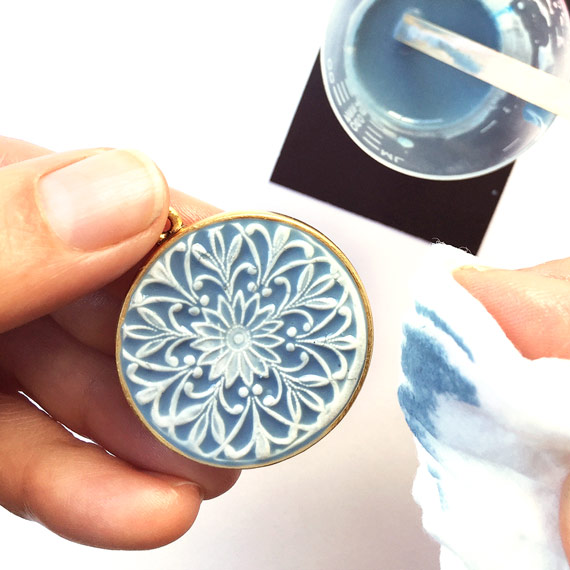
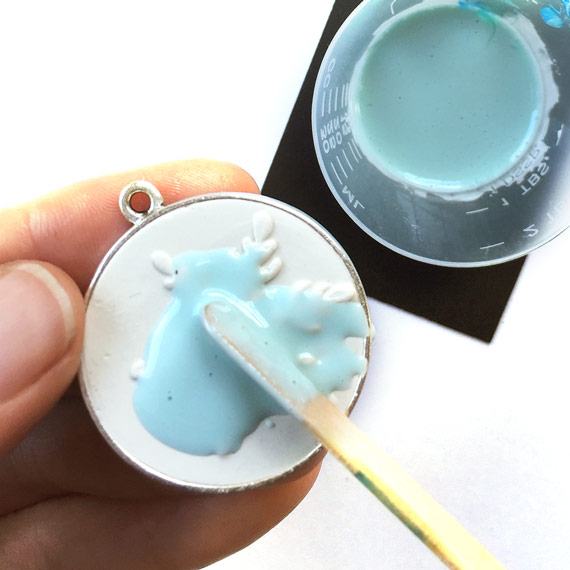

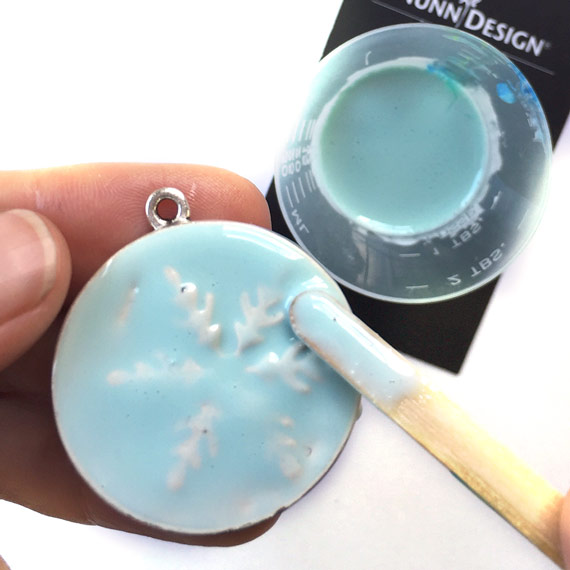
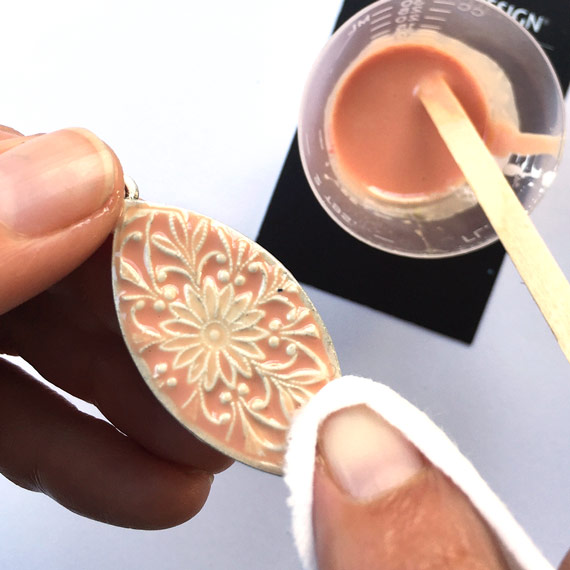
Step 20. If you would like to add additional colorized resin in areas that need it, use a toothpick to apply and move the resin around.
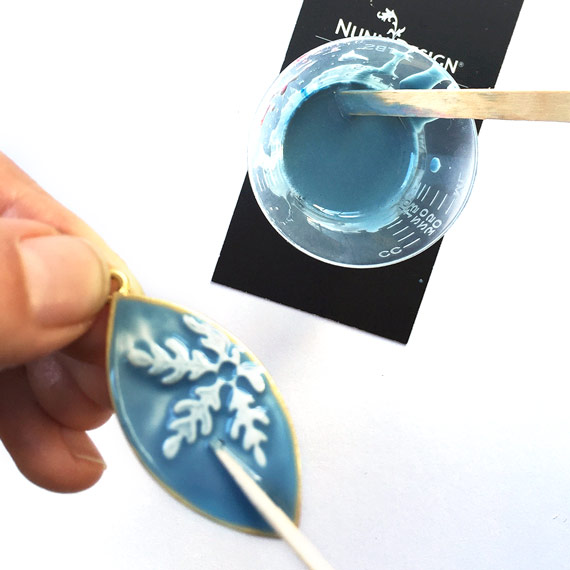
Step 21. Let the resin cure for 12-14 hours. It will be hard to the touch, but resin continues to cure for the next 72 hours. Place a small plastic container over the bezels to prevent dust from getting into the resin as it cures.
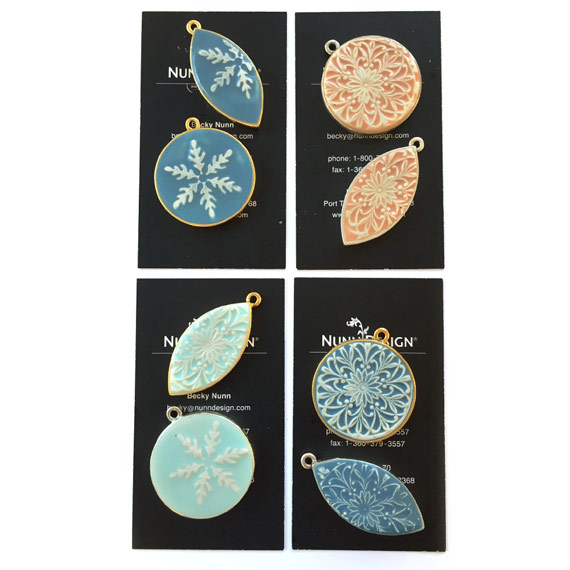
Step 22. If you have resin that has over-poured or seeped under the bezel and onto the card, wait about 6 hours until the resin is at its “soft cure” phase. Remove the bezel from the card. The resin will still be soft. Use a pair of needle-nose pliers to bend back the resin from the bezel. The resin will easily separate and peel off of the bezel.
Design Option:
Step 23. For a design option on a couple of the pieces, I added clear resin over the top of the cured colorized resin coat to provide it with a high gloss look.
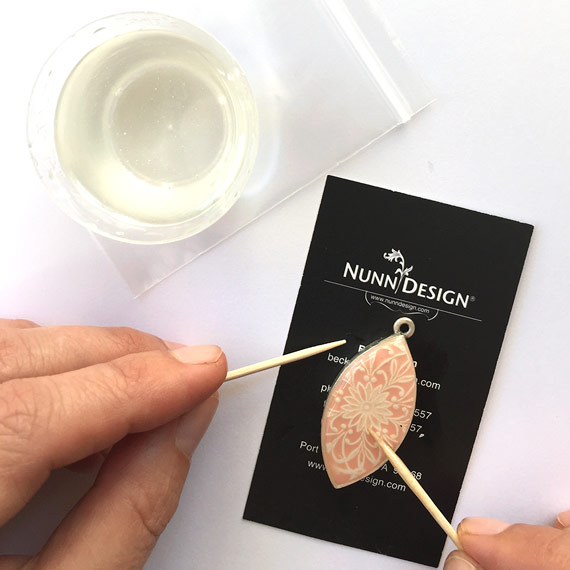
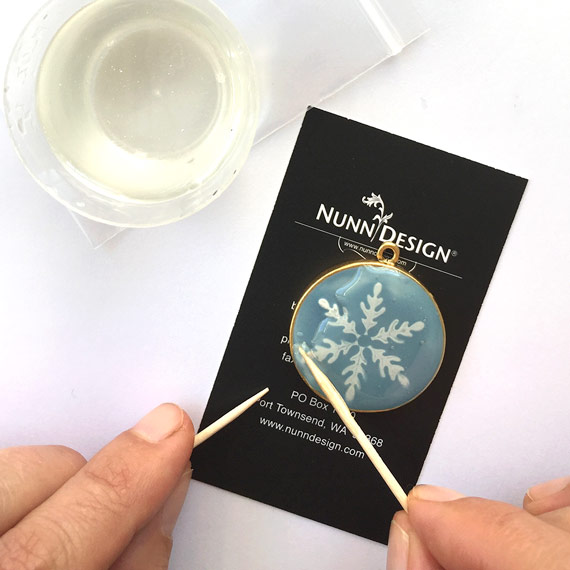

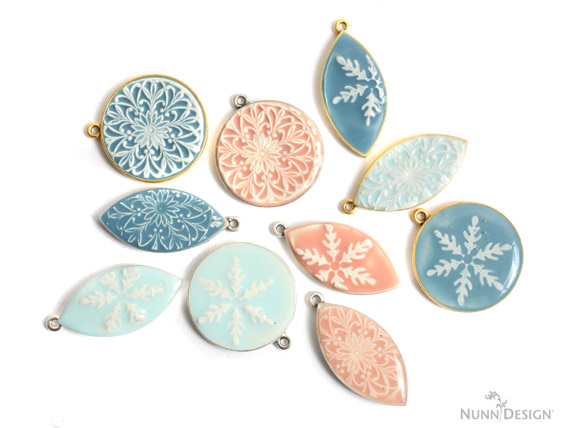
Assembling the Ornament
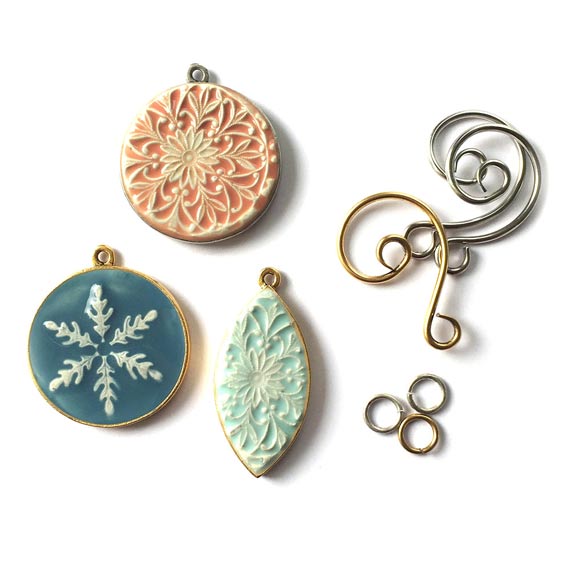
Step 24. Use two pair of needle-nose pliers to open up one of the Large Jumprings.
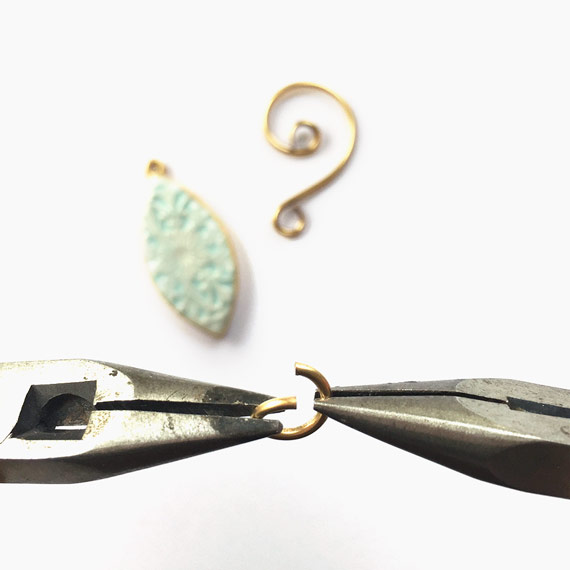
Step 25. Thread the Ornament Hook and the cured Holiday Ornament onto the open Large Jumprings.
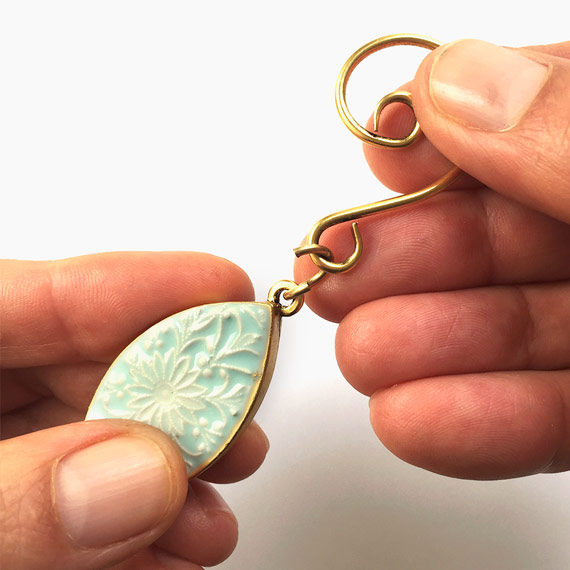
Use the two pair of needle-nose pliers to close the large jumpring.
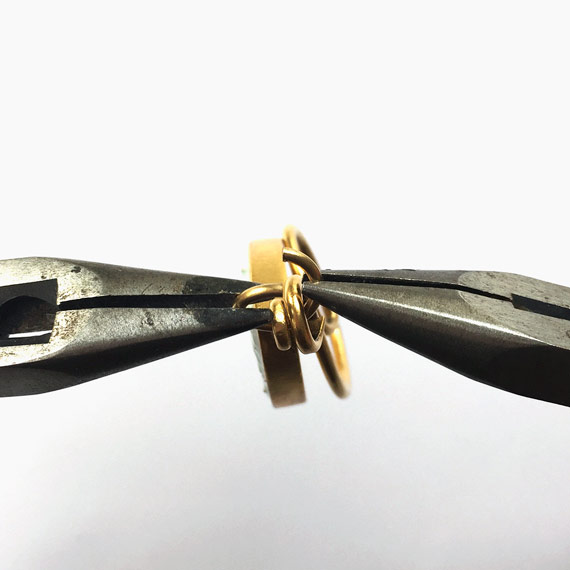
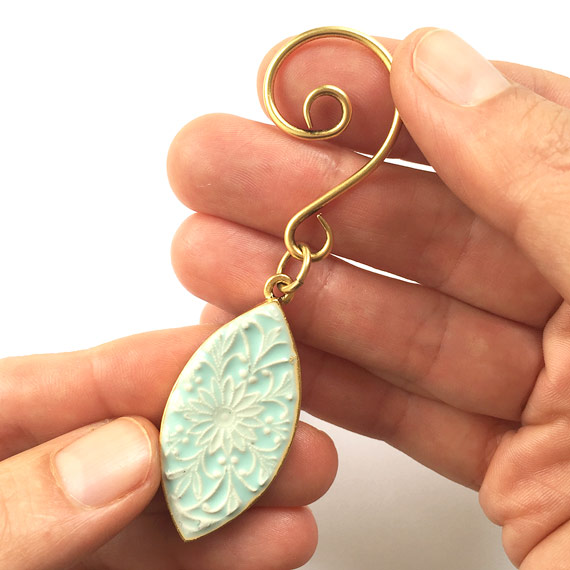
Shop Nunn Design Wholesale
Nunn Design has been supplying jewelry artists with findings for over 20 years. Shop wholesale jewelry findings for creative jewelry makers.
Shop Nunn Design!How to Purchase Wholesale?
If you are interested in becoming one of the many designers who trust their jewelry to Nunn Design Findings, please join us by registering to become one of our wholesale customers!
Please visit our Where to Buy Page for a listing of online stores that sell Nunn Design Findings retail.
If you enjoyed reading this post, please subscribe to our blog. Here are 10 Reasons Why to Subscribe and a place to do so!







Thank you so much for sharing.
I gonna have a go to make these.
I hope I can find epoxy crystal clay in the Netherlands.